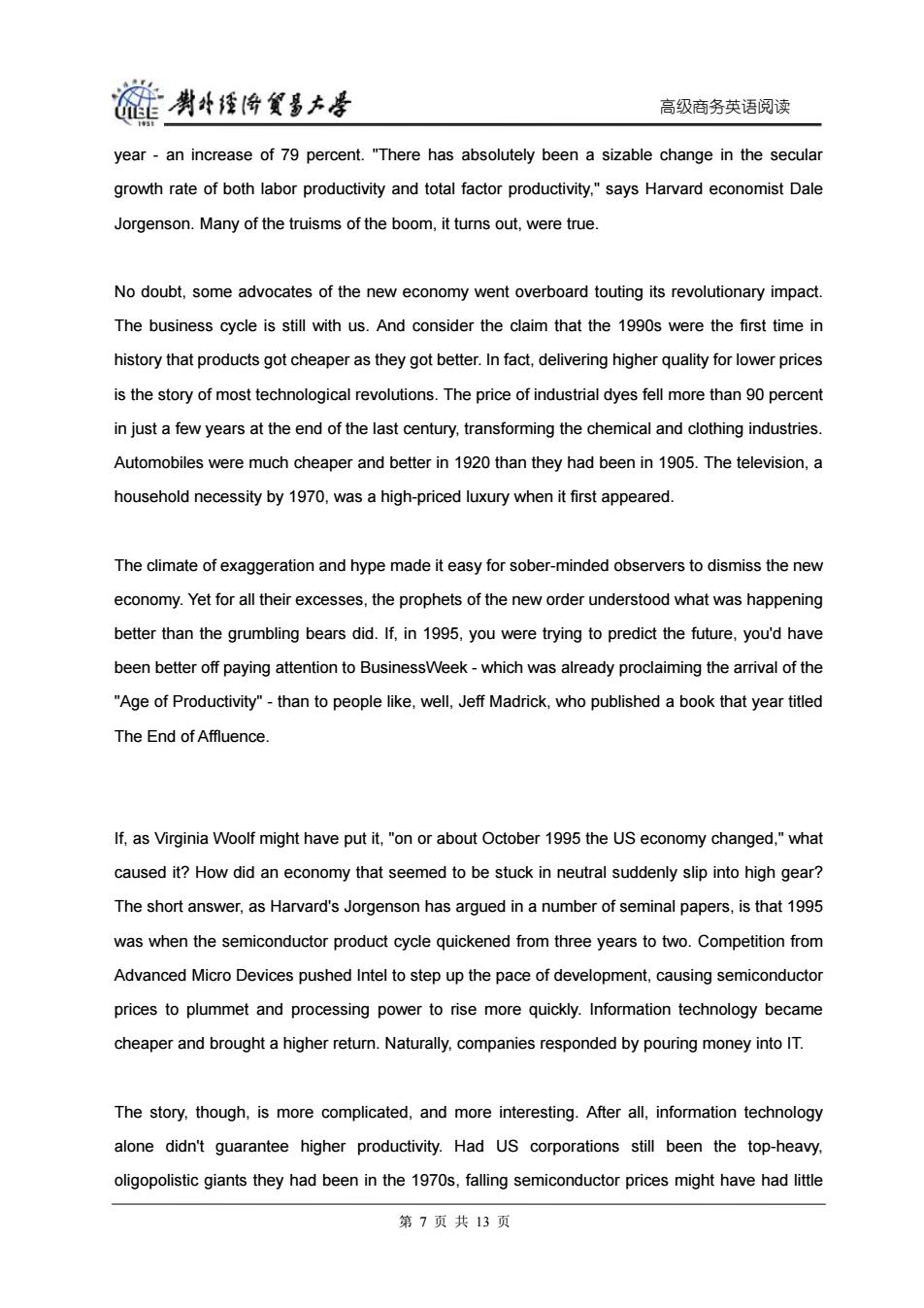正在加载图片...

碰男华经海贸多大学 高级商务英语阅读 year-an increase of 79 percent."There has absolutely been a sizable change in the secular growth rate of both labor productivity and total factor productivity,"says Harvard economist Dale Jorgenson.Many of the truisms of the boom,it turns out,were true. No doubt,some advocates of the new economy went overboard touting its revolutionary impact. The business cycle is still with us.And consider the claim that the 1990s were the first time in history that products got cheaper as they got better.In fact,delivering higher quality for lower prices is the story of most technological revolutions.The price of industrial dyes fell more than 90 percent in just a few years at the end of the last century,transforming the chemical and clothing industries. Automobiles were much cheaper and better in 1920 than they had been in 1905.The television,a household necessity by 1970,was a high-priced luxury when it first appeared. The climate of exaggeration and hype made it easy for sober-minded observers to dismiss the new economy.Yet for all their excesses,the prophets of the new order understood what was happening better than the grumbling bears did.If,in 1995,you were trying to predict the future,you'd have been better off paying attention to BusinessWeek-which was already proclaiming the arrival of the "Age of Productivity"-than to people like,well,Jeff Madrick,who published a book that year titled The End of Affluence If,as Virginia Woolf might have put it,"on or about October 1995 the US economy changed,"what caused it?How did an economy that seemed to be stuck in neutral suddenly slip into high gear? The short answer,as Harvard's Jorgenson has argued in a number of seminal papers,is that 1995 was when the semiconductor product cycle quickened from three years to two.Competition from Advanced Micro Devices pushed Intel to step up the pace of development,causing semiconductor prices to plummet and processing power to rise more quickly.Information technology became cheaper and brought a higher return.Naturally,companies responded by pouring money into IT. The story,though,is more complicated,and more interesting.After all,information technology alone didn't guarantee higher productivity.Had US corporations still been the top-heavy, oligopolistic giants they had been in the 1970s,falling semiconductor prices might have had little 第7页共13页高级商务英语阅读 year - an increase of 79 percent. "There has absolutely been a sizable change in the secular growth rate of both labor productivity and total factor productivity," says Harvard economist Dale Jorgenson. Many of the truisms of the boom, it turns out, were true. No doubt, some advocates of the new economy went overboard touting its revolutionary impact. The business cycle is still with us. And consider the claim that the 1990s were the first time in history that products got cheaper as they got better. In fact, delivering higher quality for lower prices is the story of most technological revolutions. The price of industrial dyes fell more than 90 percent in just a few years at the end of the last century, transforming the chemical and clothing industries. Automobiles were much cheaper and better in 1920 than they had been in 1905. The television, a household necessity by 1970, was a high-priced luxury when it first appeared. The climate of exaggeration and hype made it easy for sober-minded observers to dismiss the new economy. Yet for all their excesses, the prophets of the new order understood what was happening better than the grumbling bears did. If, in 1995, you were trying to predict the future, you'd have been better off paying attention to BusinessWeek - which was already proclaiming the arrival of the "Age of Productivity" - than to people like, well, Jeff Madrick, who published a book that year titled The End of Affluence. If, as Virginia Woolf might have put it, "on or about October 1995 the US economy changed," what caused it? How did an economy that seemed to be stuck in neutral suddenly slip into high gear? The short answer, as Harvard's Jorgenson has argued in a number of seminal papers, is that 1995 was when the semiconductor product cycle quickened from three years to two. Competition from Advanced Micro Devices pushed Intel to step up the pace of development, causing semiconductor prices to plummet and processing power to rise more quickly. Information technology became cheaper and brought a higher return. Naturally, companies responded by pouring money into IT. The story, though, is more complicated, and more interesting. After all, information technology alone didn't guarantee higher productivity. Had US corporations still been the top-heavy, oligopolistic giants they had been in the 1970s, falling semiconductor prices might have had little 第 7 页 共 13 页